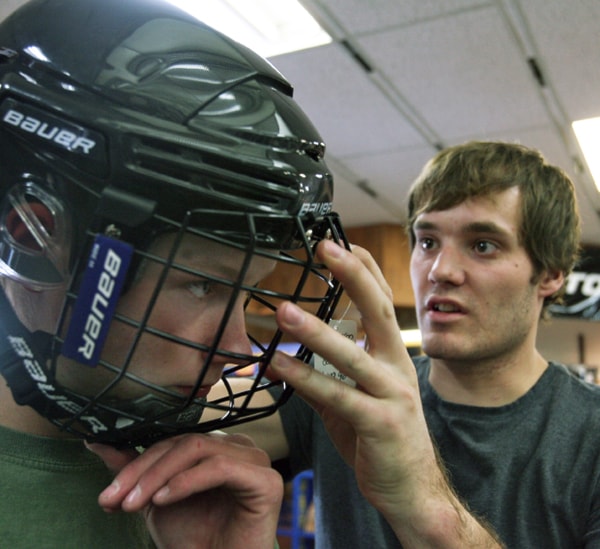A well-designed and properly fitted helmet is first line of defence against concussion, says the president of the Red Deer Minor Hockey Association.
Todd Thiessen got firsthand experience with concussion recently, when his 15-year-old son, Mathew, developed a severe headache the day after an on-ice collision with a member of his own team.
“My son is out right now because of symptoms of a concussion. His player had another guy lined up and the other guy stepped out of the way. My son came out of the players’ box, stepped on the ice and got corked.”
Mathew shook it off and continued playing.
That evening, he told his dad that he was getting a headache.
Mathew was in to see the doctor the next day. Whether he suffered a full-blown concussion has not been determined and Mathew has been getting better every day, Thiessen said.
The danger is always there, even when there is no intent to injure, and there are long-term repercussions for players who suffer a blow to the head, he said. “There is no magic medication to solve a bruised brain. All you can do is rest.”
Recent events affecting professional hockey players, particularly the two hits that sidelined Pittsburgh Penguins star Sidney Crosby last January, have raised awareness of just how dangerous head injuries can be for players at all levels, he said.
Red Deer minor hockey will enforce a new rule Hockey Canada passed about three weeks ago that calls for penalties whenever a player suffers a blow to the head, including accidental collisions like the one in which Mathew was injured.
Coaches in Red Deer are also required to attend checking clinics so they can teach their players the proper way to give a hit and take a hit.
In Alberta, children play no-contact hockey up to peewee age, which starts at 11, said Thiessen. But, even when hits aren’t allowed, there is always a risk of taking an accidental blow.
Hockey Canada’s new rule in effect this season provides no tolerance for shots to the head, including accidental hits, with minor penalties prescribed if a player’s stick, body or equipment accidentally contacts another player’s head, face or neck.
In parallel with its new rules, Hockey Canada has developed a questionnaire to help coaches, trainers and parents watch for signs that a player has suffered a concussion.
While rules and coaching help limit the number of injuries, helmets play a critical role in reducing the severity of injury when a player does take a hit, said Thiessen.
“The technology in new helmets its amazing. They’re much better than where they were even five years ago,” he said.
New technology is also available to determine if a player has suffered a blow severe enough to cause problems.
Source for Sports stores, including Sports World in Red Deer, have been invited to carry a sensor that is attached to the chinstrap on hockey and football helmets. The sensor activates LED lights whenever a player takes a blow that is hard enough to cause a concussion, said Jamie Duncan, a co-owner of the Red Deer store.
While they’re helpful in alerting players and coaches to a potentially dangerous injury, the chin cups do not function in prevention and are extremely expensive, said Duncan. They will retail at $180 to $200 each if the store decides to start carrying them, he said. That decision will be based on whether they can get a better deal from their supplier.
The Duncans do not believe the chin cups will be a hot seller, in part because they are so pricey and also because they are only supposed to last for two years.
At the same time, Sports World and other stores in the Source For Sports network are running clinics this week to help hockey players.
Through today, people can bring their helmets in for a checkup, including ensuring that they fit properly and replacing worn or damaged parts as required, said Duncan.
The helmet clinic is being run from 9:30 a.m. to 5 p.m. today.
bkossowan@www.reddeeradvocate.com
— copyright Red Deer Advocate
